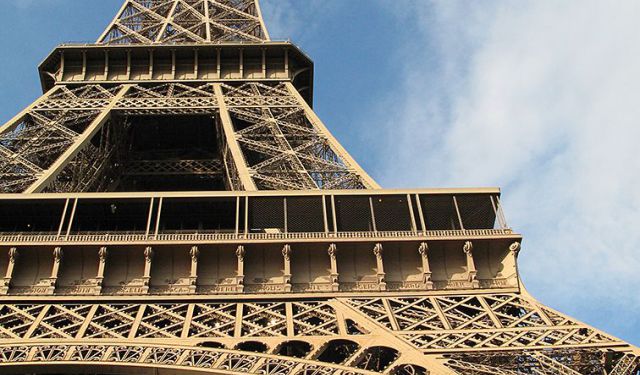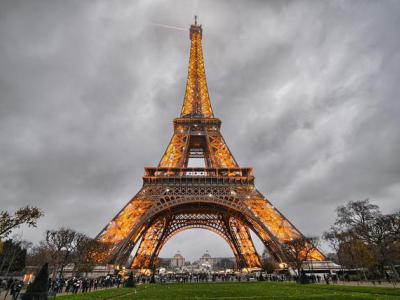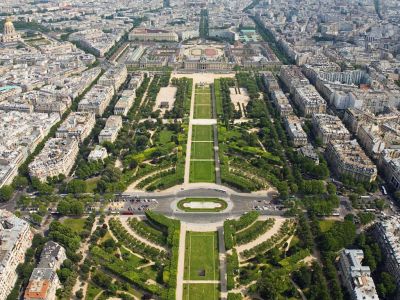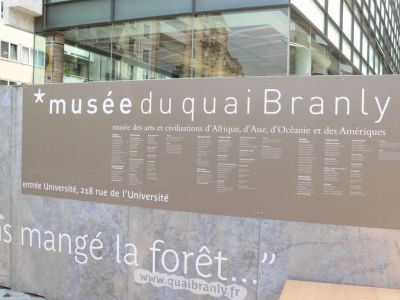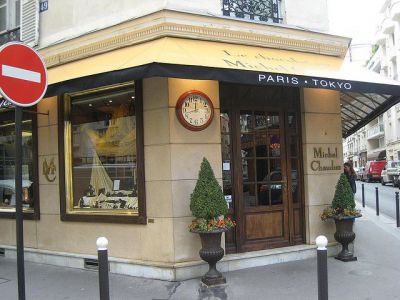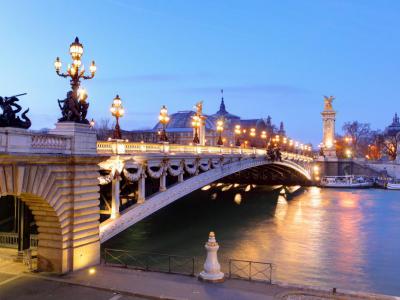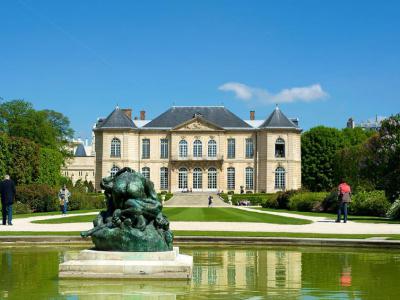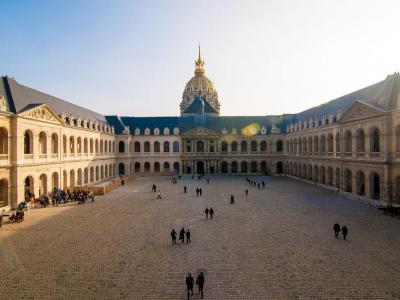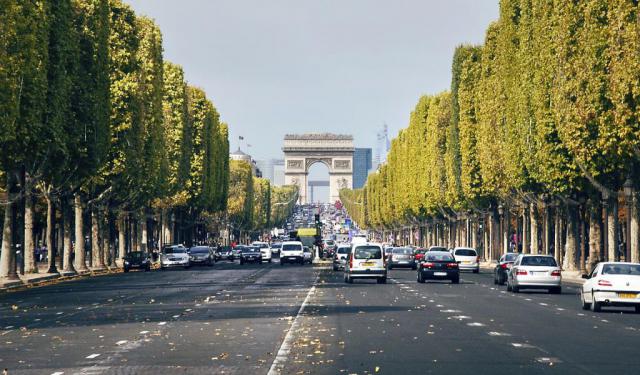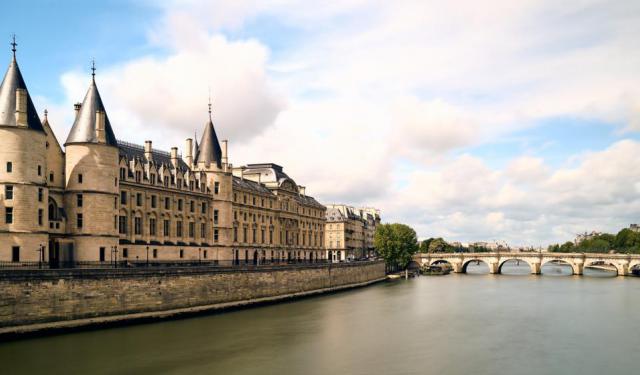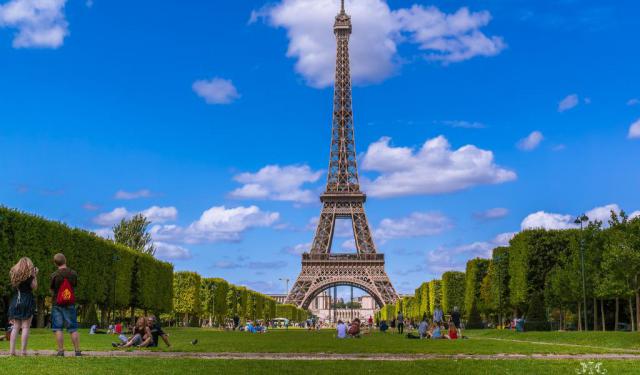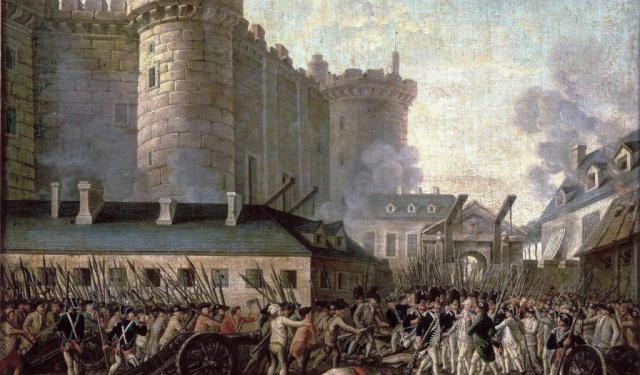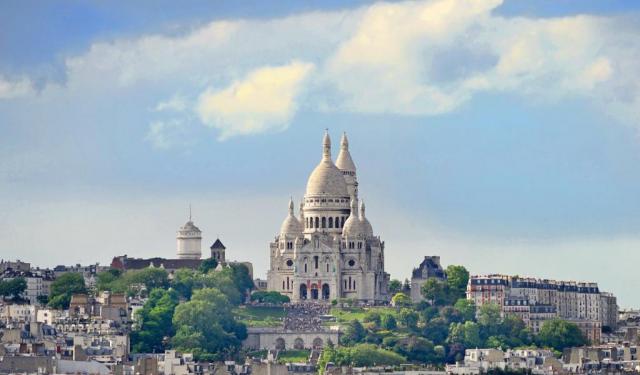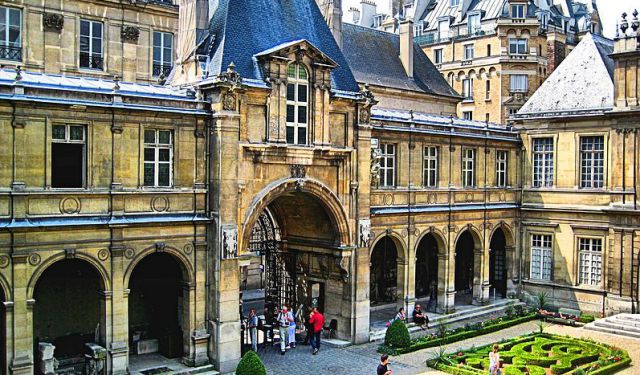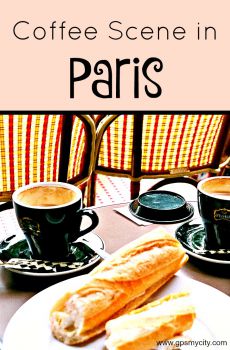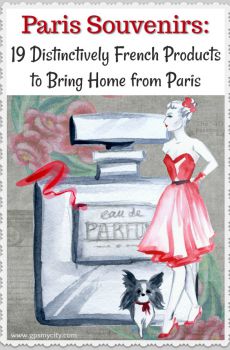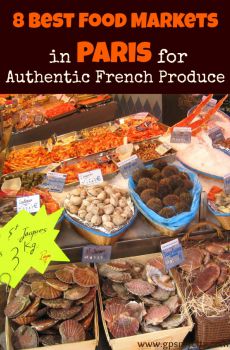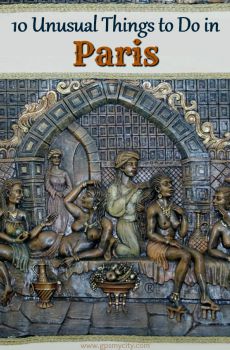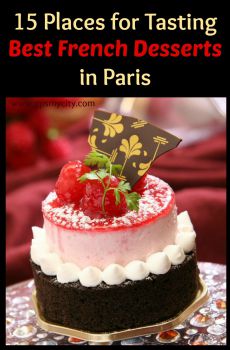Audio Guide: Eiffel Tower Walking Tour (Self Guided), Paris
The 7th administrative district of Paris, a beacon of affluence and prestige, hosts an elite residential community and numerous national institutions of France, government offices, and diplomatic missions. This historical neighborhood is famed for its quintessentially Parisian architecture, vibrant cafés, restaurants, and gourmet shops that attract food enthusiasts from around the world.
Central to the district is the iconic Eiffel Tower. A symbol of engineering prowess and elegance, it rises majestically above the Field of Mars, a vast, green space that invites visitors for leisurely strolls and picnics in the shade of this iron marvel.
A short walk from the tower, the Jacques Chirac Museum of Branly Quay is a modern architectural achievement and a significant cultural attraction. It displays an impressive collection of 19th- and 20th-century indigenous art from non-Western cultures, including Africa, Asia, Oceania, and the Americas. Another local attraction is Maison Chaudun, an old-fashioned chocolate shop. It offers exquisitely sculpted chocolates and molded 'bonbons' that are as much a feast for the eyes as they are for the palate.
For those who appreciate grand architecture, the Alexandre III Bridge represents a stunning example of ornamental design complemented by amazing views from every angle. This bridge links the Left Bank to the majestic House of Invalids, a golden-domed complex that once served as a hospital and retirement home for war veterans and now houses a military museum and the tomb of Napoleon Bonaparte. Art enthusiasts can also visit the nearby Rodin Museum. Dedicated to the French sculptor Auguste Rodin, it provides a contemplative experience with its indoor galleries and a captivating sculpture garden.
The exploration concludes at Rue Cler, a popular market street bustling with local life. This vibrant thoroughfare offers a wide array of shops and eateries where visitors can indulge in authentic French gastronomy and fresh produce.
This neighborhood encapsulates the essence of Paris, from monumental splendor to intimate street corners. Anyone who is a history buff, art enthusiast, or simply in search of a picturesque locale, will find plenty of room for exploration in the area around the Eiffel Tower. To fully experience the unique blend of history, art, and Parisian life, consider following this self-guided walk to make the most of your visit.
Central to the district is the iconic Eiffel Tower. A symbol of engineering prowess and elegance, it rises majestically above the Field of Mars, a vast, green space that invites visitors for leisurely strolls and picnics in the shade of this iron marvel.
A short walk from the tower, the Jacques Chirac Museum of Branly Quay is a modern architectural achievement and a significant cultural attraction. It displays an impressive collection of 19th- and 20th-century indigenous art from non-Western cultures, including Africa, Asia, Oceania, and the Americas. Another local attraction is Maison Chaudun, an old-fashioned chocolate shop. It offers exquisitely sculpted chocolates and molded 'bonbons' that are as much a feast for the eyes as they are for the palate.
For those who appreciate grand architecture, the Alexandre III Bridge represents a stunning example of ornamental design complemented by amazing views from every angle. This bridge links the Left Bank to the majestic House of Invalids, a golden-domed complex that once served as a hospital and retirement home for war veterans and now houses a military museum and the tomb of Napoleon Bonaparte. Art enthusiasts can also visit the nearby Rodin Museum. Dedicated to the French sculptor Auguste Rodin, it provides a contemplative experience with its indoor galleries and a captivating sculpture garden.
The exploration concludes at Rue Cler, a popular market street bustling with local life. This vibrant thoroughfare offers a wide array of shops and eateries where visitors can indulge in authentic French gastronomy and fresh produce.
This neighborhood encapsulates the essence of Paris, from monumental splendor to intimate street corners. Anyone who is a history buff, art enthusiast, or simply in search of a picturesque locale, will find plenty of room for exploration in the area around the Eiffel Tower. To fully experience the unique blend of history, art, and Parisian life, consider following this self-guided walk to make the most of your visit.
How it works: Download the app "GPSmyCity: Walks in 1K+ Cities" from Apple App Store or Google Play Store to your mobile phone or tablet. The app turns your mobile device into a personal tour guide and its built-in GPS navigation functions guide you from one tour stop to next. The app works offline, so no data plan is needed when traveling abroad.
Eiffel Tower Walking Tour Map
Guide Name: Eiffel Tower Walking Tour
Guide Location: France » Paris (See other walking tours in Paris)
Guide Type: Self-guided Walking Tour (Sightseeing)
# of Attractions: 8
Tour Duration: 2 Hour(s)
Travel Distance: 4.6 Km or 2.9 Miles
Author: DanaOffice
Sight(s) Featured in This Guide:
Guide Location: France » Paris (See other walking tours in Paris)
Guide Type: Self-guided Walking Tour (Sightseeing)
# of Attractions: 8
Tour Duration: 2 Hour(s)
Travel Distance: 4.6 Km or 2.9 Miles
Author: DanaOffice
Sight(s) Featured in This Guide:
- Tour Eiffel (Eiffel Tower)
- Champ de Mars (Field of Mars)
- Musee du quai Branly – Jacques Chirac (Jacques Chirac Museum of Branly Quay)
- Maison Chaudun (chocolate store)
- Pont Alexandre III (Alexandre III Bridge)
- Musee Rodin (Rodin Museum)
- Hotel des Invalides (House of The Invalids)
- Rue Cler (Market Street)
1) Tour Eiffel (Eiffel Tower) (must see)
Equally grand from whatever angle you look at it, whether just walking past or watching it from a distance, day or night, the Eiffel Tower lives up to its iconic status easily. The wrought-iron lattice structure on the Field of Mars in Paris was designed by engineer Gustave Eiffel and built between 1887 and 1889. Known locally as the "Iron Lady," it was the centerpiece of the 1889 World's Fair, celebrating the centennial of the French Revolution.
Illuminated by gas lamps at night, the tower was a major attraction from the very beginning, although not to everyone's taste. Before its construction even started, a group of prominent French artists and intellectuals, including writer Guy de Maupassant, condemned the tower as a "monstrous" and "useless" structure that would overshadow Paris' landmarks. By 1918, however, it had become an iconic symbol of Paris – and France – and since then has been one of the most recognizable landmarks in the world.
Standing at 330 meters (or 1,083 feet), the Eiffel Tower is the tallest structure in Paris. It has three levels for visitors, with restaurants on the first and second. The top level, at 276 meters (or 906 feet), offers the highest public observation deck in the European Union. Visitors can ascend via stairs or lift, with 600 steps required to reach the second level. The third level, typically accessed by lift, features a private apartment once used by Gustave Eiffel, where he hosted honorable guests like Thomas Edison.
In recognition of their contribution to the construction, the tower is engraved with the names of 72 French scientists, engineers, and mathematicians.
Unlike other high risers, the Eiffel Tower is there for visitors only. In Paris, where tall buildings are still in short supply, the bird's eye view from the top of the tower is truly unique and indeed breathtaking. In 2022, the tower welcomed nearly six million visitors, becoming the most visited paid monument globally.
The Eiffel Tower is painted in three shades: darker at the bottom, getting progressively lighter towards the top to complement the Parisian sky. Originally reddish brown, it changed the color to bronze, known as "Eiffel Tower Brown," in 1968. In what is expected to be a temporary change, the Eiffel Tower was painted gold in commemoration of the 2024 Summer Olympics in Paris.
Tip:
Remember to bring along some warm clothes, because it can get much colder up there, especially when it's windy.
During the day, if it's hot, bring an umbrella, too, to get some shade, and lots of water.
Illuminated by gas lamps at night, the tower was a major attraction from the very beginning, although not to everyone's taste. Before its construction even started, a group of prominent French artists and intellectuals, including writer Guy de Maupassant, condemned the tower as a "monstrous" and "useless" structure that would overshadow Paris' landmarks. By 1918, however, it had become an iconic symbol of Paris – and France – and since then has been one of the most recognizable landmarks in the world.
Standing at 330 meters (or 1,083 feet), the Eiffel Tower is the tallest structure in Paris. It has three levels for visitors, with restaurants on the first and second. The top level, at 276 meters (or 906 feet), offers the highest public observation deck in the European Union. Visitors can ascend via stairs or lift, with 600 steps required to reach the second level. The third level, typically accessed by lift, features a private apartment once used by Gustave Eiffel, where he hosted honorable guests like Thomas Edison.
In recognition of their contribution to the construction, the tower is engraved with the names of 72 French scientists, engineers, and mathematicians.
Unlike other high risers, the Eiffel Tower is there for visitors only. In Paris, where tall buildings are still in short supply, the bird's eye view from the top of the tower is truly unique and indeed breathtaking. In 2022, the tower welcomed nearly six million visitors, becoming the most visited paid monument globally.
The Eiffel Tower is painted in three shades: darker at the bottom, getting progressively lighter towards the top to complement the Parisian sky. Originally reddish brown, it changed the color to bronze, known as "Eiffel Tower Brown," in 1968. In what is expected to be a temporary change, the Eiffel Tower was painted gold in commemoration of the 2024 Summer Olympics in Paris.
Tip:
Remember to bring along some warm clothes, because it can get much colder up there, especially when it's windy.
During the day, if it's hot, bring an umbrella, too, to get some shade, and lots of water.
2) Champ de Mars (Field of Mars)
In sunny weather, there is nothing better in Paris than stretching out somewhere on a grassy lawn. A public park between the Eiffel Tower and the Military School, the Field of Mars, is one of the largest parks in Paris and generously offers such an opportunity to those lucky with lots of time under their belt.
This popular outdoor space derives its name from the ancient Mars Field in Rome, once the drilling ground for the Roman armies, dedicated to the Roman god of war. Similarly, the area in Paris was also used originally for military drills. At some point, before its transformation in the 16th century, this flat, open terrain was used for market gardening, though it was not highly fertile.
In 1765, the construction of the Military School began shaping the Field of Mars into its present form. The park was developed with an esplanade, a noble facade, a large ditch, elm avenues, and an enclosing grille fence. Additionally, the Isle of Swans, a small islet near the Eiffel Tower, was attached to the shore for aesthetic symmetry.
The Field of Mars has historical significance, hosting the first hydrogen-filled balloon flight in 1783, as well as several major events during the French Revolution, including the 1790 Federation Day celebration, now known as Bastille Day. However, it was also the site of the 1791 Field of Mars massacre and the execution of the first mayor of Paris, who was guillotined there in 1793. In 1815, during Napoleon’s Hundred Days, the field hosted the so-called “Field of May” public assembly to rally support for Napoleon’s liberal reform.
The park also hosted Universal Exhibitions in 1867, 1878, 1889, 1900, and 1937. For the 2024 Summer Olympics and Paralympics, it housed the Eiffel Tower Stadium and the Grand Ephemeral Palace, a temporary exhibition hall, hosting beach volleyball, blind football, and portions of the opening ceremony. Today, it continues to be a significant green space with sports facilities like basketball and football fields.
A favorite spot for many, the Field of Mars can get rather busy on sunny days. Those coming with kids will find several playgrounds available at their disposal.
Tip:
Consider bringing a mat or cover for lying about.
This popular outdoor space derives its name from the ancient Mars Field in Rome, once the drilling ground for the Roman armies, dedicated to the Roman god of war. Similarly, the area in Paris was also used originally for military drills. At some point, before its transformation in the 16th century, this flat, open terrain was used for market gardening, though it was not highly fertile.
In 1765, the construction of the Military School began shaping the Field of Mars into its present form. The park was developed with an esplanade, a noble facade, a large ditch, elm avenues, and an enclosing grille fence. Additionally, the Isle of Swans, a small islet near the Eiffel Tower, was attached to the shore for aesthetic symmetry.
The Field of Mars has historical significance, hosting the first hydrogen-filled balloon flight in 1783, as well as several major events during the French Revolution, including the 1790 Federation Day celebration, now known as Bastille Day. However, it was also the site of the 1791 Field of Mars massacre and the execution of the first mayor of Paris, who was guillotined there in 1793. In 1815, during Napoleon’s Hundred Days, the field hosted the so-called “Field of May” public assembly to rally support for Napoleon’s liberal reform.
The park also hosted Universal Exhibitions in 1867, 1878, 1889, 1900, and 1937. For the 2024 Summer Olympics and Paralympics, it housed the Eiffel Tower Stadium and the Grand Ephemeral Palace, a temporary exhibition hall, hosting beach volleyball, blind football, and portions of the opening ceremony. Today, it continues to be a significant green space with sports facilities like basketball and football fields.
A favorite spot for many, the Field of Mars can get rather busy on sunny days. Those coming with kids will find several playgrounds available at their disposal.
Tip:
Consider bringing a mat or cover for lying about.
3) Musee du quai Branly – Jacques Chirac (Jacques Chirac Museum of Branly Quay)
The Jacques Chirac Museum of Branly Quay is the newest major museum in Paris, opened in 2006. Designed by the renowned French architect Jean Nouvel, it is considered an architectural attraction in its own right. The museum is dedicated to the indigenous arts and cultures of Africa, Asia, Oceania, and the Americas, and as such showcases a staggering collection of over one million items, including ethnographic objects, photographs, and documents. Of these, 3,500 items are displayed at any given time through both permanent and temporary thematic exhibits.
Situated near the Eiffel Tower and the Alma Bridge, the museum serves as both a vibrant showcase of non-European cultures and a center for scholarly research. Realized during Jacques Chirac's presidency, it reflects a longstanding tradition of French presidents endorsing significant cultural projects.
The building itself, designed to foster an inclusive viewing experience, stretches 210 meters and covers an area of 4,750 square meters. It features a vast roof terrace and a main gallery that leads visitors through a winding, darkened ramp ideal for viewing displays. The museum complex also includes classrooms, an auditorium, and a multimedia library, among other facilities.
Upon entering the main building, visitors are greeted by an enormous Moai ancestor carving from Easter Island. The African collection includes masks, tapestries, and textiles. The Asian collection features the back of a seat of honor from Sumatra, figurines and masks from India, and textiles from China.
The Americas collection showcases Mayan artifacts from 600 AD, Aztec sculptures, and Canadian totem poles. Meanwhile, the Oceania collection comprises figurines from Papua New Guinea, masks from Vanuatu, and Māori sculptures from New Zealand.
The museum's library complements its rich collection, offering vast resources including a significant archive of photographs, documents, and numerous books accessible through its dual-structured reading rooms.
Externally, the museum's gardens are an innovative departure from traditional French formal gardens, featuring a blend of native and Paris-acclimated plants spread across 17,500 square meters of streams, hills, and groves, protected from street noise by a high wall of plate glass. The exterior wall is covered by a green carpet of living plants that spans over 800 square meters.
Situated near the Eiffel Tower and the Alma Bridge, the museum serves as both a vibrant showcase of non-European cultures and a center for scholarly research. Realized during Jacques Chirac's presidency, it reflects a longstanding tradition of French presidents endorsing significant cultural projects.
The building itself, designed to foster an inclusive viewing experience, stretches 210 meters and covers an area of 4,750 square meters. It features a vast roof terrace and a main gallery that leads visitors through a winding, darkened ramp ideal for viewing displays. The museum complex also includes classrooms, an auditorium, and a multimedia library, among other facilities.
Upon entering the main building, visitors are greeted by an enormous Moai ancestor carving from Easter Island. The African collection includes masks, tapestries, and textiles. The Asian collection features the back of a seat of honor from Sumatra, figurines and masks from India, and textiles from China.
The Americas collection showcases Mayan artifacts from 600 AD, Aztec sculptures, and Canadian totem poles. Meanwhile, the Oceania collection comprises figurines from Papua New Guinea, masks from Vanuatu, and Māori sculptures from New Zealand.
The museum's library complements its rich collection, offering vast resources including a significant archive of photographs, documents, and numerous books accessible through its dual-structured reading rooms.
Externally, the museum's gardens are an innovative departure from traditional French formal gardens, featuring a blend of native and Paris-acclimated plants spread across 17,500 square meters of streams, hills, and groves, protected from street noise by a high wall of plate glass. The exterior wall is covered by a green carpet of living plants that spans over 800 square meters.
4) Maison Chaudun (chocolate store)
Michel Chaudun, a name synonymous with masterful chocolate craftsmanship, established his eponymous store on University Street in Paris in 1986. His new venture quickly gained popularity, enchanting generations of Parisian children with its magical window displays and becoming the first French chocolatier to expand to Japan, in 1991.
For Chaudun, chocolate is not just food but an art form, demanding a perfect balance of flavors. Here, they practice assemblage, skillfully blending different cocoa vintages from major producers to craft a unique, harmonious chocolate experience. This approach is likened to a symphony of subtle, elegant flavors that create complex sensory experiences, contrasting with the trend towards single-variety chocolates.
A signature creation, the Pavé, epitomizes Maison Chaudun’s philosophy of combining technical sophistication with elegant simplicity. Introduced in 1991, these small squares of soft ganache delicately dusted with cocoa encapsulate the essence of Chaudun’s style. Pavés are more delicate and short-lived by all accounts: a chocolate creation that is much more than a truffle.
Further innovating, Chaudun developed a unique chocolate bar with cocoa nibs in 1993, inspired by a request for coffee bean chocolate. This led to the creation of a distinctive chocolate using freshly roasted cocoa beans, a method that remains partially secret and inimitable.
Recently, Maison Chaudun has returned to its roots, offering a select array of cakes and pastries that blend the art of chocolate with contemporary pastry techniques, available in variations like Dark Pavé or White Pavé. These pavés and their awesome bonbons are a true delight.
Lately, Maison Chaudun has also expanded its repertoire to include candied fruits from Corsica, adhering to the same high standards of natural, quality ingredients without artificial enhancements. For a burst of tangy sunshine, try these!
Additionally, visitors can admire or purchase fabulous chocolate handbags and statues, which are not only great sculptures but also delicious. Although one may be tempted to buy a box of chocolates as a gift or for later, these heavenly treats are very unlikely to make it home. ;)
For Chaudun, chocolate is not just food but an art form, demanding a perfect balance of flavors. Here, they practice assemblage, skillfully blending different cocoa vintages from major producers to craft a unique, harmonious chocolate experience. This approach is likened to a symphony of subtle, elegant flavors that create complex sensory experiences, contrasting with the trend towards single-variety chocolates.
A signature creation, the Pavé, epitomizes Maison Chaudun’s philosophy of combining technical sophistication with elegant simplicity. Introduced in 1991, these small squares of soft ganache delicately dusted with cocoa encapsulate the essence of Chaudun’s style. Pavés are more delicate and short-lived by all accounts: a chocolate creation that is much more than a truffle.
Further innovating, Chaudun developed a unique chocolate bar with cocoa nibs in 1993, inspired by a request for coffee bean chocolate. This led to the creation of a distinctive chocolate using freshly roasted cocoa beans, a method that remains partially secret and inimitable.
Recently, Maison Chaudun has returned to its roots, offering a select array of cakes and pastries that blend the art of chocolate with contemporary pastry techniques, available in variations like Dark Pavé or White Pavé. These pavés and their awesome bonbons are a true delight.
Lately, Maison Chaudun has also expanded its repertoire to include candied fruits from Corsica, adhering to the same high standards of natural, quality ingredients without artificial enhancements. For a burst of tangy sunshine, try these!
Additionally, visitors can admire or purchase fabulous chocolate handbags and statues, which are not only great sculptures but also delicious. Although one may be tempted to buy a box of chocolates as a gift or for later, these heavenly treats are very unlikely to make it home. ;)
5) Pont Alexandre III (Alexandre III Bridge) (must see)
Of all the beautiful bridges spanning the Seine in Paris, the Alexandre III Bridge is celebrated as the city's most ornate and extravagant. Built as part of the preparations for the 1900 World Exhibition, it epitomizes the architectural and artistic grandeur of the Belle Époque. The bridge connects the Champs-Élysées quarter to the areas near the Invalides complex and the Eiffel Tower. In recognition of its historical and cultural significance, it was declared a French historic monument in 1975.
Named after Tsar Alexander III of Russia, who solidified the Franco-Russian Alliance in 1892, the bridge features elaborate Beaux-Arts styling with Art Nouveau elements, including ornate lamps, cherubs, nymphs, and winged horses at both ends. This aesthetic continuity aligns with the Grand Palace across the river, emphasizing a cohesive visual narrative across the cityscape. The foundational stone was placed by Tsar Alexander's son, Nicholas II, in 1896, reinforcing the diplomatic symbolism the bridge carried.
A genuine feat of engineering for its time, showcasing a 6-meter-high single-span steel arch, it was designed to preserve unobstructed views along the Champs-Élysées and towards the Invalides, integrating the structure seamlessly with its surroundings.
Prominently, the bridge is adorned with statues by various sculptors, adding layers of artistic merit. Four gilt-bronze statues of Fames, resting on large masonry socles at each end of the bridge, symbolize different aspects of French culture and achievement. These include the Fame of the Sciences and the Fame of the Arts on the Right Bank and the Fame of Commerce and the Fame of Industry on the Left Bank, each flanked by corresponding figures representing different eras of France, from Charlemagne to Louis XIV to Contemporary France.
The piers and groynes supporting the lower part of the bridge are also impressive, especially for those who sail underneath it.
The center of the bridge features hammered copper nymph reliefs, commemorating the Franco-Russian Alliance, with one facing toward Paris and the other toward Imperial Russia. This symbolic decor is echoed in the Trinity Bridge in Saint Petersburg, also a Franco-Russian memorial, underscoring the deep cultural and political connections between the two countries.
Tip:
If you happen to be on the bridge at night, make sure to walk down the stairs and check out its underbelly for some truly amazing photos.
Also, look out for a small antiques market down there, along the riverfront, for some vintage fashion, excellent silver flatware, and knick-knacks of various sort.
Named after Tsar Alexander III of Russia, who solidified the Franco-Russian Alliance in 1892, the bridge features elaborate Beaux-Arts styling with Art Nouveau elements, including ornate lamps, cherubs, nymphs, and winged horses at both ends. This aesthetic continuity aligns with the Grand Palace across the river, emphasizing a cohesive visual narrative across the cityscape. The foundational stone was placed by Tsar Alexander's son, Nicholas II, in 1896, reinforcing the diplomatic symbolism the bridge carried.
A genuine feat of engineering for its time, showcasing a 6-meter-high single-span steel arch, it was designed to preserve unobstructed views along the Champs-Élysées and towards the Invalides, integrating the structure seamlessly with its surroundings.
Prominently, the bridge is adorned with statues by various sculptors, adding layers of artistic merit. Four gilt-bronze statues of Fames, resting on large masonry socles at each end of the bridge, symbolize different aspects of French culture and achievement. These include the Fame of the Sciences and the Fame of the Arts on the Right Bank and the Fame of Commerce and the Fame of Industry on the Left Bank, each flanked by corresponding figures representing different eras of France, from Charlemagne to Louis XIV to Contemporary France.
The piers and groynes supporting the lower part of the bridge are also impressive, especially for those who sail underneath it.
The center of the bridge features hammered copper nymph reliefs, commemorating the Franco-Russian Alliance, with one facing toward Paris and the other toward Imperial Russia. This symbolic decor is echoed in the Trinity Bridge in Saint Petersburg, also a Franco-Russian memorial, underscoring the deep cultural and political connections between the two countries.
Tip:
If you happen to be on the bridge at night, make sure to walk down the stairs and check out its underbelly for some truly amazing photos.
Also, look out for a small antiques market down there, along the riverfront, for some vintage fashion, excellent silver flatware, and knick-knacks of various sort.
6) Musee Rodin (Rodin Museum) (must see)
The Rodin Museum in Paris, established in 1919, is dedicated to the works of French sculptor Auguste Rodin. It is situated in the elegant 18th-century mansion called Hôtel Biron, which the sculptor used as his workshop from 1908. Rodin bequeathed his comprehensive collection of sculptures, alongside notable paintings by Vincent van Gogh, Claude Monet, and Pierre-Auguste Renoir to the French State under the condition that his workshop be transformed into a museum showcasing his artistry.
The museum is home to over 6,600 sculptures, including prominent pieces like The Thinker, The Kiss, and The Gates of Hell, many of which are displayed within its extensive garden. The outside garden itself, spanning over three hectares, is an integral part of the museum experience and features a variety of Rodin’s famous sculptures set against a backdrop of natural scenery. Just behind the museum, there's a casual restaurant and a small lake, plus an open area with benches, a café, and an ice-cream parlor.
Renowned for his unique ability to mold clay, Rodin went down in history not only as a sculptor but also as a painter, engraver, and collector. Attesting to this are 8,000 drawings that reflect a range of styles from landscape observations to fantastical works influenced by literary figures like Dante and Baudelaire. The collection also encompasses 7,000 old photographs that Rodin himself collected, showcasing his deep interest in photography as both a science and an art. These photographs serve as a historical archive of Rodin’s creative process and personal interests.
Additionally, the museum honors Camille Claudel, Rodin’s student, collaborator, and lover, with a dedicated room displaying her works, including The Mature Age and The Waltz, among others, capturing their tumultuous relationship and her artistic journey.
Rodin’s legacy is further highlighted through his vast collection of ancient and Eastern art, accumulated over the last two decades of his life, displayed amidst his own creations, signifying his appreciation and inspiration drawn from global art traditions.
While celebrating Rodin’s artistic contributions, the museum also engages with contemporary art through temporary exhibitions, hosting works by modern artists and organizing events that connect the historical with the contemporary.
The entrance fee is reasonable and not likely to break anyone's bank, so you can go and appreciate art from a whole new perspective while enjoying the Parisian weather.
Tip:
Do stop in the entry garden to pose for cheesy photos of yourself looking pensive next to the massive statue of The Thinker!
Regular Hours:
Wednesday-Monday: 10 am-5 pm
Closed Tuesdays, 4th of July, Thanksgiving, and Christmas
Garden Bar Hours:
Thursday–Sunday: 3–8 pm (July 5–August 25); Saturday, Sunday: 3–8 pm (September 8–29);
Closed July 25, August 31–September 2, September 7
The museum is home to over 6,600 sculptures, including prominent pieces like The Thinker, The Kiss, and The Gates of Hell, many of which are displayed within its extensive garden. The outside garden itself, spanning over three hectares, is an integral part of the museum experience and features a variety of Rodin’s famous sculptures set against a backdrop of natural scenery. Just behind the museum, there's a casual restaurant and a small lake, plus an open area with benches, a café, and an ice-cream parlor.
Renowned for his unique ability to mold clay, Rodin went down in history not only as a sculptor but also as a painter, engraver, and collector. Attesting to this are 8,000 drawings that reflect a range of styles from landscape observations to fantastical works influenced by literary figures like Dante and Baudelaire. The collection also encompasses 7,000 old photographs that Rodin himself collected, showcasing his deep interest in photography as both a science and an art. These photographs serve as a historical archive of Rodin’s creative process and personal interests.
Additionally, the museum honors Camille Claudel, Rodin’s student, collaborator, and lover, with a dedicated room displaying her works, including The Mature Age and The Waltz, among others, capturing their tumultuous relationship and her artistic journey.
Rodin’s legacy is further highlighted through his vast collection of ancient and Eastern art, accumulated over the last two decades of his life, displayed amidst his own creations, signifying his appreciation and inspiration drawn from global art traditions.
While celebrating Rodin’s artistic contributions, the museum also engages with contemporary art through temporary exhibitions, hosting works by modern artists and organizing events that connect the historical with the contemporary.
The entrance fee is reasonable and not likely to break anyone's bank, so you can go and appreciate art from a whole new perspective while enjoying the Parisian weather.
Tip:
Do stop in the entry garden to pose for cheesy photos of yourself looking pensive next to the massive statue of The Thinker!
Regular Hours:
Wednesday-Monday: 10 am-5 pm
Closed Tuesdays, 4th of July, Thanksgiving, and Christmas
Garden Bar Hours:
Thursday–Sunday: 3–8 pm (July 5–August 25); Saturday, Sunday: 3–8 pm (September 8–29);
Closed July 25, August 31–September 2, September 7
7) Hotel des Invalides (House of The Invalids)
The House of the Invalids, or simply "The Invalides," is a monumental complex that showcases France's military history through its museums and monuments. Initially founded by Louis XIV in 1670, this historic site was intended to serve as a hospital and retirement home for war veterans. Originally, the complex had 15 courtyards, with the largest reserved for military parades. The hospital was capable of housing up to 4,000 veterans at a time. During the French Revolution, the complex played a crucial role. On 14 July 1789, before attacking the Bastille fortress, a mob broke into The Invalides and seized 32,000 rifles, which proved decisive in starting the fight.
Today, the site encompasses several museums, including the Army Museum, the Museum of Military Models, and the Museum of Contemporary History, alongside the Cathedral of Saint Louis of The Invalides, the national cathedral of the French military. The Army Museum recounts French military history from the Middle Ages to WWII, featuring medieval armor, Renaissance weapons, Napoleonic artifacts, and visual records of wars through photography and film, highlighting key historical moments and the evolution of military technology.
The architectural centerpiece of The Invalides is the Dome, an architectural marvel, which stands as Paris's tallest church at 107 meters. The temple follows a Greek cross layout and features a facade with two superimposed orders, capped by a grand dome topped with a lantern. This structure not only adds to the visual splendor of the site with its Baroque influence and celestial paintings by French painter Charles de La Fosse but also serves a functional purpose. It houses two churches: the veterans' chapel and the upper chapel which was used occasionally by the royal family.
Significant for its burials, the Dome's Royal Chapel is also known as a military necropolis. Notably, it includes the tomb of Napoleon Bonaparte, which has become a major landmark. Napoleon's remains were returned from Saint Helena in 1840 and placed within a meticulously crafted sarcophagus set in a prominent crypt surrounded by a circular gallery. The sheer size of the Dome, and that of the sarcophagus beneath it, vividly demonstrate the importance of Napoleon to the French people. This site encapsulates French military heritage, with various military figures also interred here.
In recent history, The Invalides expanded its role during the Paris 2024 Summer Olympics, hosting events like archery and road cycling on the Esplanade of The Invalides.
Tip:
If you come late, toward the closing hours, you may have a bit more space to walk around and explore this place on your own.
The available on-site Angelina patisserie offers visitors a fairly good selection of teas and cakes, ideal for a quick snack and a nice break whenever you might need it.
Today, the site encompasses several museums, including the Army Museum, the Museum of Military Models, and the Museum of Contemporary History, alongside the Cathedral of Saint Louis of The Invalides, the national cathedral of the French military. The Army Museum recounts French military history from the Middle Ages to WWII, featuring medieval armor, Renaissance weapons, Napoleonic artifacts, and visual records of wars through photography and film, highlighting key historical moments and the evolution of military technology.
The architectural centerpiece of The Invalides is the Dome, an architectural marvel, which stands as Paris's tallest church at 107 meters. The temple follows a Greek cross layout and features a facade with two superimposed orders, capped by a grand dome topped with a lantern. This structure not only adds to the visual splendor of the site with its Baroque influence and celestial paintings by French painter Charles de La Fosse but also serves a functional purpose. It houses two churches: the veterans' chapel and the upper chapel which was used occasionally by the royal family.
Significant for its burials, the Dome's Royal Chapel is also known as a military necropolis. Notably, it includes the tomb of Napoleon Bonaparte, which has become a major landmark. Napoleon's remains were returned from Saint Helena in 1840 and placed within a meticulously crafted sarcophagus set in a prominent crypt surrounded by a circular gallery. The sheer size of the Dome, and that of the sarcophagus beneath it, vividly demonstrate the importance of Napoleon to the French people. This site encapsulates French military heritage, with various military figures also interred here.
In recent history, The Invalides expanded its role during the Paris 2024 Summer Olympics, hosting events like archery and road cycling on the Esplanade of The Invalides.
Tip:
If you come late, toward the closing hours, you may have a bit more space to walk around and explore this place on your own.
The available on-site Angelina patisserie offers visitors a fairly good selection of teas and cakes, ideal for a quick snack and a nice break whenever you might need it.
8) Rue Cler (Market Street)
Rue Cler, nestled in the 7th administrative district of Paris, stands out as one of the city's finest market streets, cherished for its vibrant blend of cafés, bakeries, and specialty shops. This pedestrian-friendly area, paved with original cobblestones, offers an authentic slice of Parisian life where locals frequent to procure gourmet delights and relish moments at café terraces.
The street owes its name to Jean Joseph Gustave Cler, a French Brigadier General who perished in the Battle of Magenta in 1859.
Architecturally, it features remarkable buildings such as the late 18th-century corner house at No. 1, a chapel at No. 5, and former residences of prominent figures like President of the Republic, Emmanuel Macron, at No. 15.
The street is abundant with specialty food stores, pastry shops, butchers, delicatessens, cheese specialists, fishmongers, greengrocers, and chocolatiers, creating a bustling atmosphere perfect for culinary exploration. On Sundays, Rue Cler springs to life even more vibrantly as families, post-mass at the nearby Saint Pierre of the Big Rock Church, gather their essentials for traditional lunches, carefully selecting items like bread, wine, and cheeses, ensuring their Camembert and Saint Felicien are at perfect ripeness.
Key establishments enhance Rue Cler's allure. For instance, Mariage Frères offers exquisite teas since 1854, and the Brasserie Aux PTT provides a quintessentially French dining experience. Also noteworthy are Davoli, known for its Italian delicacies and the best Choucroute in Paris, and La Sablaise Poissonnerie, a premier fish merchant renowned for its fresh daily catch.
For those with a sweet tooth, the street boasts renowned chocolatiers and patisseries. The François Pralus establishment, with its whimsical chocolate eclair bench, delights both children and adults, while Amorino's Italian gelato and New Asia's takeout add international flavors. At the same time, the Café du Marché and Tribeca café offer ideal spots for people-watching and savoring daily specials.
Rue Cler not only serves as a shopping haven but also a cultural touchstone reflecting the everyday lifestyle of Parisians. This street offers a unique opportunity to dive deep into the heart of Parisian gastronomy and tradition, perfect for anyone wanting to experience the authentic pulse of Paris.
The street owes its name to Jean Joseph Gustave Cler, a French Brigadier General who perished in the Battle of Magenta in 1859.
Architecturally, it features remarkable buildings such as the late 18th-century corner house at No. 1, a chapel at No. 5, and former residences of prominent figures like President of the Republic, Emmanuel Macron, at No. 15.
The street is abundant with specialty food stores, pastry shops, butchers, delicatessens, cheese specialists, fishmongers, greengrocers, and chocolatiers, creating a bustling atmosphere perfect for culinary exploration. On Sundays, Rue Cler springs to life even more vibrantly as families, post-mass at the nearby Saint Pierre of the Big Rock Church, gather their essentials for traditional lunches, carefully selecting items like bread, wine, and cheeses, ensuring their Camembert and Saint Felicien are at perfect ripeness.
Key establishments enhance Rue Cler's allure. For instance, Mariage Frères offers exquisite teas since 1854, and the Brasserie Aux PTT provides a quintessentially French dining experience. Also noteworthy are Davoli, known for its Italian delicacies and the best Choucroute in Paris, and La Sablaise Poissonnerie, a premier fish merchant renowned for its fresh daily catch.
For those with a sweet tooth, the street boasts renowned chocolatiers and patisseries. The François Pralus establishment, with its whimsical chocolate eclair bench, delights both children and adults, while Amorino's Italian gelato and New Asia's takeout add international flavors. At the same time, the Café du Marché and Tribeca café offer ideal spots for people-watching and savoring daily specials.
Rue Cler not only serves as a shopping haven but also a cultural touchstone reflecting the everyday lifestyle of Parisians. This street offers a unique opportunity to dive deep into the heart of Parisian gastronomy and tradition, perfect for anyone wanting to experience the authentic pulse of Paris.
Walking Tours in Paris, France
Create Your Own Walk in Paris
Creating your own self-guided walk in Paris is easy and fun. Choose the city attractions that you want to see and a walk route map will be created just for you. You can even set your hotel as the start point of the walk.
Champs-Elysees Walking Tour
On this self-guided walk you will witness the grandeur of the 8th arrondissement of the French capital – one of its busiest and chic neighborhoods, thanks to the presence of Avenue des Champs-Elysées, Arc de Triomphe, and Place de la Concorde.
Your best plan would be to start with the Triumphal Arch and walk up to its viewing area for great sights down the Champs-Élysées – a lovely... view more
Tour Duration: 2 Hour(s)
Travel Distance: 4.7 Km or 2.9 Miles
Your best plan would be to start with the Triumphal Arch and walk up to its viewing area for great sights down the Champs-Élysées – a lovely... view more
Tour Duration: 2 Hour(s)
Travel Distance: 4.7 Km or 2.9 Miles
Paris Introduction Walking Tour II
As you continue your acquaintance with Paris driven by its timeless allure, the city's heart reveals itself with an array of places capturing its profound history and artistic legacy. The evolution of Paris is visible on the banks of the river Seine, the linking thread winding its way through the capital as if keeping a watchful eye on its architectural marvels.
The second part of our... view more
Tour Duration: 2 Hour(s)
Travel Distance: 4.4 Km or 2.7 Miles
The second part of our... view more
Tour Duration: 2 Hour(s)
Travel Distance: 4.4 Km or 2.7 Miles
Paris Introduction Walking Tour I
Paris, the capital of France, has a history spanning over 2,000 years back to the Iron Age. The name “Paris” comes from the Parisii, a Gallic tribe that settled on the bank of the river Seine around the 3rd century BC. Having conquered the Galls, the Romans established on their land a garrison town known as Lutetia. By the end of the 5th century AD, it fell to the Franks and flourished under... view more
Tour Duration: 2 Hour(s)
Travel Distance: 5.1 Km or 3.2 Miles
Tour Duration: 2 Hour(s)
Travel Distance: 5.1 Km or 3.2 Miles
The French Revolution Landmarks Walking Tour
The French Revolution had a huge impact on France's history as it gave rise to a radical democratic republic and resulted in quite a bit of violence during the infamous "Reign of Terror". Even though many of Paris’ buildings were damaged in the course of the bloody conflicts, the sites they occupied – which you can find on this self-guided tour – are of a great historical... view more
Tour Duration: 3 Hour(s)
Travel Distance: 7.3 Km or 4.5 Miles
Tour Duration: 3 Hour(s)
Travel Distance: 7.3 Km or 4.5 Miles
Montmartre Walking Tour
Originally known as "Mons Martis" or the "Mount of Mars," Montmartre is a renowned Parisian neighborhood, celebrated for its historical and cultural significance. This picturesque district is a canvas of landmarks, each narrating a unique story.
Apart from its iconic sites, the area's charm lies in the atmosphere that embodies the Parisian spirit. Historically,... view more
Tour Duration: 2 Hour(s)
Travel Distance: 2.7 Km or 1.7 Miles
Apart from its iconic sites, the area's charm lies in the atmosphere that embodies the Parisian spirit. Historically,... view more
Tour Duration: 2 Hour(s)
Travel Distance: 2.7 Km or 1.7 Miles
Le Marais Walking Tour
Once a bourgeois area and still a major center of the Paris Jewish community, the Le Marais district is one of the hippest neighborhoods in the city. Boasting a wealth of narrow medieval streets, unique boutiques, and quirky establishments, it represents an eclectic blend of historical sites and the bustling energy of today.
Start your acquaintance with the area at Paris's City Hall – a... view more
Tour Duration: 1 Hour(s)
Travel Distance: 2.4 Km or 1.5 Miles
Start your acquaintance with the area at Paris's City Hall – a... view more
Tour Duration: 1 Hour(s)
Travel Distance: 2.4 Km or 1.5 Miles
Useful Travel Guides for Planning Your Trip
8 Must Try Cafes in Paris
Discovering the best coffee and cafes in Paris can be difficult. The city is filled to the brim with brasseries and cafes, but very few offer the Anglophone standard of a good cup of coffee. This is a guide to inform tourists and Parisians alike of the new and somewhat established cafes in Paris...
Paris Souvenirs: 19 Distinctively French Products to Bring Home from Paris
You can hardly have enough money and luggage space to get all the takes your fancy in Paris. Luckily, with a little bit of tasteful advice and experience, you can save yourself some time and effort and pick up just about the right amount of things worth taking home. Listed here are some of the hints...
8 Best Food Markets in Paris for Authentic French Produce
The image of Parisians that you may have in your head as strolling through a colourful market with a basket on their arm, chatting to vendors and picking up fresh produce, is quite accurate. Most Parisians do visit local markets at least once a week to stock up on the freshest fruit, vegetables,...
10 Unusual Things to Do in Paris, France
If you've visited Paris, you've probably seen the Eiffel Tower, Notre Dame, and Versailles. You probably whizzed through some world-class art, ate delicious food in restaurants with English menus, and bought crepes from a street cart. However, Paris has a lot of things to do that...
Top 16 Vegetarian Restaurants in Paris
The French have great respect for the fresh, organic produce yet France isn’t famous for its vegetarian cooking. Hence it’s a good idea for vegetarian visitors to Paris to come prepared in advance. This guide shows you places around the city which serve vegetarian food, complete with the...
14 Places for Tasting Best French Desserts in Paris
If you have a sweet tooth and it wishes to "eat your way" through Paris, this guide will show you how! Featured here are some of the most famous and prominent dessert spots in the French capital, where you can grab something sweet to enjoy. With 20 listed recommendations, you should be...
The Most Popular Cities
/ view all
